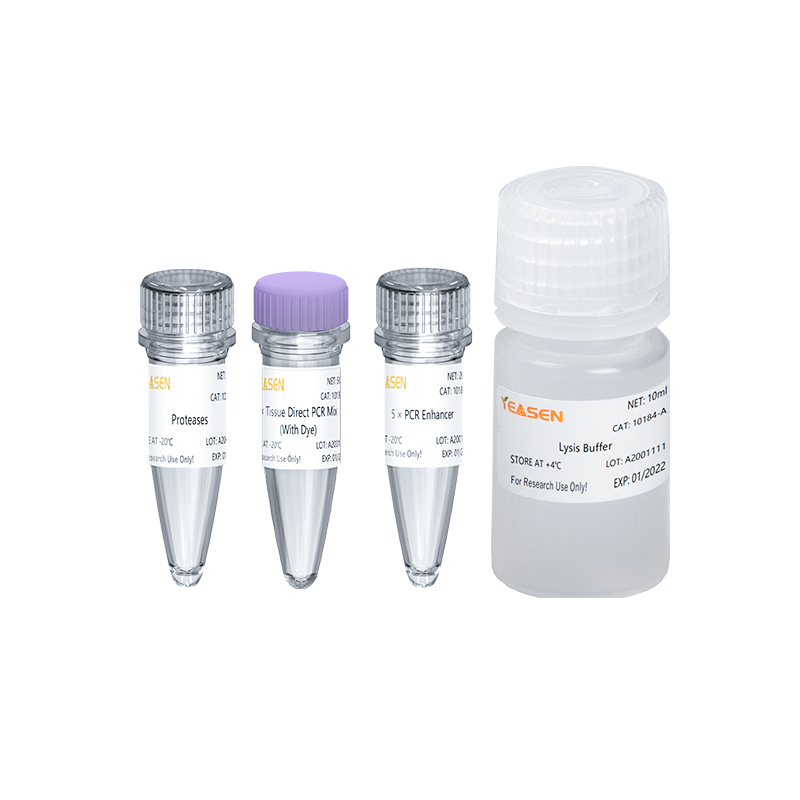Animal Tissue Direct PCR Kit (With Dye)
Product Description
Animal Tissue Direct PCR Kit is a kit that designed for PCR amplification directly from different animal tissues, with wide adaptability, strong stability and easy operation.
The kit uses a unique lysis buffer system, which can lyse a variety of animal tissue samples quickly and then release genomic DNA, such as insect foot wings, mouse tails, mouse toes, animal skin and internal organs. The lysate can be used for DNA extraction and purification, PCR reactions, or stored at -20°C or below for long-term use.
In the kit, the 2× Tissue Direct PCR Mix (With Dye) is highly compatible with amplification. There is no need to remove various debris impurities using additional purification and extraction reagents in the lysate. It directly uses the lysate of the sample to be tested as a template for amplification efficiently and specifically. The Animal Tissue Direct PCR Kit includes PCR reaction mixture (2×), a ready-to-use PCR mix comprising all the components for PCR amplification, except primers and template, which simplifies the operation of the amplification step and reduces the probability of contamination greatly.
The kit can be used for animal gene amplification detection and transgenic animal genotype identification.
Shipping
The components are shipped with ice packs and can be stored for 1 year.
Storage
1. Reagent 10184-A [Lysis Buffer] is animal tissue lysis buffer, it is recommended to store at 2-8℃.
2. Reagent 10184-B [Proteases] is an animal tissue lysing agent. Do not open the cap for a long time when using it. It is recommended to store at -20°C to avoid repeated freezing and thawing.
3. Reagent 10184-C [2× Tissue Direct PCR Mix (With Dye)], it is recommended to store at -20℃ to avoid repeated freezing and thawing.
4. Reagent 10184-D [5× PCR Enhancer], it is recommended to store at -20°C to avoid repeated freezing and thawing.
Cautions
1. It is recommended to use freshly collected animal tissues. If the tissues are frozen for a long time, repeated freezing and thawing should be avoided as much as possible, otherwise the template will be degraded and the PCR efficiency will be affected.
2. For your safety and health, please wear lab coats and disposable gloves for operation.
3. This product is for research use ONLY!
|
Common problems |
Possible causes |
Solutions |
|
No bands in the positive control and the samples to be tested. |
The PCR reaction system or reaction conditions are not suitable. |
Use gradient PCR to explore the optimal reaction conditions for PCR. |
|
PCR Reagent loses activity due to improper storage. |
2× PCR Mix should be stored at -20℃. Avoid repeated freezing and thawing when using. If used frequently, it can be stored at 4°C for a short time. |
|
|
Primer design. |
Try redesigning the primers. |
|
|
The positive control has a band of interest, and the sample to be tested has no band or a weak band. |
Improper storage or prolonged storage causes loss of reagent activity. |
Replace with new reagents. |
|
Excessive tissue lysate. |
Increase the reaction system, or reduce the amount of lysate. |
|
|
Improper or prolonged storage of the lysate result in the degradation of the DNA genome. |
Lysis mix can be stored at 4°C for 2-3 days. Use a freshly prepared lysate mix for PCR. |
|
|
The amount of template added is not suitable. |
In the range of 5-20% of the reaction system, optimize the amount of template added. |
|
|
Insufficient number of PCR cycles. |
Increase the number of PCR cycles appropriately, preferably 35-40 cycles. Because the template is complex, it is better to use 5-10 more cycles of PCR than using purified DNA template. |
|
|
Nonspecific amplification. |
PCR annealing temperature too low, cycle number, primer concentration, or template concentration too high. |
Increase PCR annealing temperature and decrease PCR cycles, primer concentration, or template concentration. |
|
PCR primers mismatch. |
Redesign PCR primers. |
|
|
The temperature is too high when preparing the PCR reaction system or the time is too long after the preparation is completed. |
Prepare PCR reaction system at low temperature. Perform PCR amplification reactions as soon as possible after preparation. |
|
|
Target band appears in negative control. |
Contamination of operating tools or reagents. |
All reagents or equipment for the experiment should be autoclaved. Be careful and gentle when handling to prevent the target sequence from being sucked into the sample gun or spilled out of the centrifuge tube. |
|
Cross-contamination between samples. |
Each sampler is only used for one sample. Or after taking a sample, immerse the sampler blade in a 2% sodium hypochlorite solution, rinse repeatedly, and then dry the residue with a clean paper towel. |
[1] Chen P, Zhou J, Wan Y, et al. A Cas12a ortholog with stringent PAM recognition followed by low off-target editing rates for genome editing. Genome Biol. 2020;21(1):78. Published 2020 Mar 25. doi:10.1186/s13059-020-01989-2(IF:10.806)
[2] Pan Y, Fang G, Wang Z, et al. Chromosome-level genome reference and genome editing of the tea geometrid. Mol Ecol Resour. 2021;21(6):2034-2049. doi:10.1111/1755-0998.13385(IF:7.090)
[3] Sun X, Zhang K, Gu J, et al. The biological characters of Bmelav-like genes in the development of Bombyx mori. Insect Mol Biol. 2021;30(1):9-17. doi:10.1111/imb.12668(IF:2.533)
Catalog No.:*
Name*
phone Number:*
Lot:*
Email*
Country:*
Company/Institute:*
Related articles

